Discover Florida Nature
It's time to explore the natural Florida


|
|
|
|
|
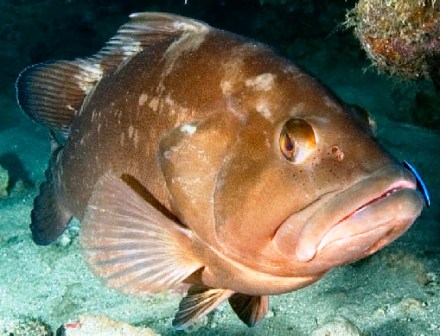 Red
Grouper (Epinephelus morio) Red grouper are easily
recognized by their color and by the sloped, straight line of their
spiny dorsal fin. The fin has a long second spine and an unnotched
interpine membrane. Most epinepheline groupers have a notched dorsal
spine membrane and a third spine longer than the second. The body is
deep brownish-red overall, with occational white spots on the sides.
Tiny black specks dot the cheeks and operculum. The red grouper is most
closely related to the Nassau grouper, Epinephelus striatus, which has
several verticle bars and blotches, and is found more commonly on coral
reefs in the West Indies. Red grouper are distributed from North
Carolina to Brazil, including the Gulf of Mexico and the Caribbean. The
species is most abundant along Florida's east and west coasts, and
throughout the Gulf of Mexico. It inhabits ledges, crevices, and caverns
of rocky limestone reefs, and also lower-provile, live-bottom areas in
waters 10 to 40 feet deep. The red grouper is a protogynous
hermaphrodite, and females are capable of reproducing at 4 years of age. Red
Grouper (Epinephelus morio) Red grouper are easily
recognized by their color and by the sloped, straight line of their
spiny dorsal fin. The fin has a long second spine and an unnotched
interpine membrane. Most epinepheline groupers have a notched dorsal
spine membrane and a third spine longer than the second. The body is
deep brownish-red overall, with occational white spots on the sides.
Tiny black specks dot the cheeks and operculum. The red grouper is most
closely related to the Nassau grouper, Epinephelus striatus, which has
several verticle bars and blotches, and is found more commonly on coral
reefs in the West Indies. Red grouper are distributed from North
Carolina to Brazil, including the Gulf of Mexico and the Caribbean. The
species is most abundant along Florida's east and west coasts, and
throughout the Gulf of Mexico. It inhabits ledges, crevices, and caverns
of rocky limestone reefs, and also lower-provile, live-bottom areas in
waters 10 to 40 feet deep. The red grouper is a protogynous
hermaphrodite, and females are capable of reproducing at 4 years of age. 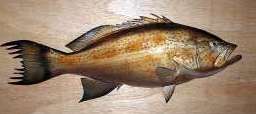 Scamp
(Mycteroperca phenax) The color of scamp grouper is a
light gray or brown, with reddish-brown spots on sides that tend to be
grouped into lines, and some yellow around the corners of mouth. Related
to the gag and other slender-bodied groupers, the scamp are identified
by their pronounced anal and soft dorsal ray extensions, a more concave
profile of the head, and by color. Scamp have a tan to grayish-brown
body covered with sharply defined, well-separated dark spots, which are
approximately an eighth of an inch in diameter. The Scamp inhabits
continental shelf waters from the Campeche Banks , in the Gulf of
Mexico, to Florida and northward along the East Coast to North Carolina.
Although the species occationally congregates over high-profile bottom,
such as wrecks and rock outcroppings, the preferred habitat is
low-profile, live bottom areas in waters 75-300 feet deep. These areas
are characterized by profuse growths of soft corals and sponges
populated by red grouper, white grunt, red porgy and numerous species of
small, tropical reef fish. Scamp are sexually mature at the age of 3
years, or those larger than 16 inches. In offshore waters from April to
May, scamp spawn thousands of pelagic eggs. They have been recorded at
age up to 21 years, but may live up to 30 years. They may reach a length
of up to 43 inches and weight of up to 36 pounds. Scamp can be
aggressive predators, capturing crabs, shrimp, and fishes and swallowing
them whole. Scamp
(Mycteroperca phenax) The color of scamp grouper is a
light gray or brown, with reddish-brown spots on sides that tend to be
grouped into lines, and some yellow around the corners of mouth. Related
to the gag and other slender-bodied groupers, the scamp are identified
by their pronounced anal and soft dorsal ray extensions, a more concave
profile of the head, and by color. Scamp have a tan to grayish-brown
body covered with sharply defined, well-separated dark spots, which are
approximately an eighth of an inch in diameter. The Scamp inhabits
continental shelf waters from the Campeche Banks , in the Gulf of
Mexico, to Florida and northward along the East Coast to North Carolina.
Although the species occationally congregates over high-profile bottom,
such as wrecks and rock outcroppings, the preferred habitat is
low-profile, live bottom areas in waters 75-300 feet deep. These areas
are characterized by profuse growths of soft corals and sponges
populated by red grouper, white grunt, red porgy and numerous species of
small, tropical reef fish. Scamp are sexually mature at the age of 3
years, or those larger than 16 inches. In offshore waters from April to
May, scamp spawn thousands of pelagic eggs. They have been recorded at
age up to 21 years, but may live up to 30 years. They may reach a length
of up to 43 inches and weight of up to 36 pounds. Scamp can be
aggressive predators, capturing crabs, shrimp, and fishes and swallowing
them whole.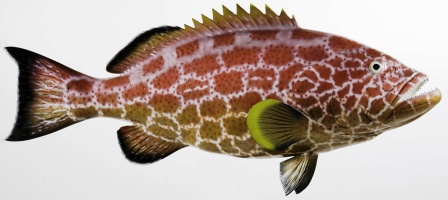 Yellowfin
Grouper
(Mycteroperca venenosa) The yellowfin grouper is a coral reef
fish native to the western Atlantic, Caribbean Sea, and Gulf of Mexico.
It is generally a denizen of the deeper reef areas but it may venture
into shallower waters, especially during the cooler seasons. The fish is
variable in color but is usually similar in appearance to the Black
Grouper. It is distinguishable by the bright yellow trim on the pectoral
fins. The yellowfin grouper is a hearty fish, often reaching 10
kilograms. It is considered quite tasty and is one of the more popular
Gulf gamefishes. It has been known to be a cause of ciguatera toxin
poisoning, however. An attractive animal, the Yellowfin Grouper is a
popular aquarium fish. This species is one of the main catches in the
fishing industry in Bermuda. It is considered overfished, and is
currently threatened in several areas. The record catch for a yellowfin
grouper in Florida is 34 pounds, 6 ounces. Yellowfin grouper mainly feed
on squid and fish. Yellowfin
Grouper
(Mycteroperca venenosa) The yellowfin grouper is a coral reef
fish native to the western Atlantic, Caribbean Sea, and Gulf of Mexico.
It is generally a denizen of the deeper reef areas but it may venture
into shallower waters, especially during the cooler seasons. The fish is
variable in color but is usually similar in appearance to the Black
Grouper. It is distinguishable by the bright yellow trim on the pectoral
fins. The yellowfin grouper is a hearty fish, often reaching 10
kilograms. It is considered quite tasty and is one of the more popular
Gulf gamefishes. It has been known to be a cause of ciguatera toxin
poisoning, however. An attractive animal, the Yellowfin Grouper is a
popular aquarium fish. This species is one of the main catches in the
fishing industry in Bermuda. It is considered overfished, and is
currently threatened in several areas. The record catch for a yellowfin
grouper in Florida is 34 pounds, 6 ounces. Yellowfin grouper mainly feed
on squid and fish. 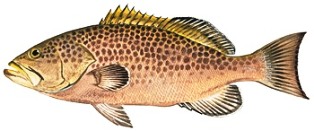 Yellowmouth
Grouper (Mycteroperca interstitialis) Yellowmouth
grouper are tan or brown with darker spots, or a network of spots, fused
into lines, and a distinct yellow wash behind the jaws, with yellow
around the eyes and the outer edges of fins. Adult yellowmouth grouper
are associated with rocky bottoms, reef, and drop off walls in water
over 60 feet deep, the young may occur inshore in shallow water. Not as
common as scamp in the Gulf of Mexico, yellowmouth grouper's range is
limited to southern Florida Common to 40 pounds, the yellowmouth grouper
may attain weights exceeding 100 pounds. This grouper feeds on small
fish and crustaceans. Yellowmouth
Grouper (Mycteroperca interstitialis) Yellowmouth
grouper are tan or brown with darker spots, or a network of spots, fused
into lines, and a distinct yellow wash behind the jaws, with yellow
around the eyes and the outer edges of fins. Adult yellowmouth grouper
are associated with rocky bottoms, reef, and drop off walls in water
over 60 feet deep, the young may occur inshore in shallow water. Not as
common as scamp in the Gulf of Mexico, yellowmouth grouper's range is
limited to southern Florida Common to 40 pounds, the yellowmouth grouper
may attain weights exceeding 100 pounds. This grouper feeds on small
fish and crustaceans.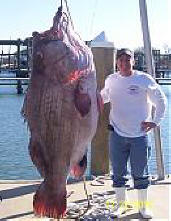 Warsaw
Grouper
(Epinephelus nigritus) The warsaw grouper is the only member of
the genus Epinephelous that has 10 dorsal spines, the second of which is
much longer than the third. The color is a grayish brown to dark
reddish-brown background with numerous small, irregular white blotches
on the sides. The color appears much lighter around the nape and along
the posterior margin of the operculum. All of the fins are dark brown,
except the white-splotched spiny portion of the dorsal fin. Warsaw
grouper range from North Carolina to the Florida Keys and throughout
much of the Caribbean and Gulf of Mexico to the northern coast of South
America. The species inhabits irregular bottom, notches, valleys, and
drop-offs, occurring in the continental shelf break in waters 350 to 650
feet deep. Other species inhabiting this productive deep-water zone are
snowy and yellowedge groupers, tilefish, and silk snappers. Warsaw are
long-lived, reaching up to 6 feet and over 300 pounds. The warsaw's huge
mouth enables it to engulf prey whole after capturing it. Warsaw
Grouper
(Epinephelus nigritus) The warsaw grouper is the only member of
the genus Epinephelous that has 10 dorsal spines, the second of which is
much longer than the third. The color is a grayish brown to dark
reddish-brown background with numerous small, irregular white blotches
on the sides. The color appears much lighter around the nape and along
the posterior margin of the operculum. All of the fins are dark brown,
except the white-splotched spiny portion of the dorsal fin. Warsaw
grouper range from North Carolina to the Florida Keys and throughout
much of the Caribbean and Gulf of Mexico to the northern coast of South
America. The species inhabits irregular bottom, notches, valleys, and
drop-offs, occurring in the continental shelf break in waters 350 to 650
feet deep. Other species inhabiting this productive deep-water zone are
snowy and yellowedge groupers, tilefish, and silk snappers. Warsaw are
long-lived, reaching up to 6 feet and over 300 pounds. The warsaw's huge
mouth enables it to engulf prey whole after capturing it.
|
|
|
Advertise | Privacy Statement | Dog Encyclopedia | Video |Contact | Alaska Nature |
|